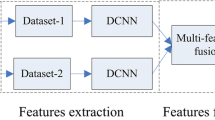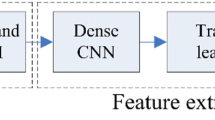Abstract
This study proposes a system for the automatic recognition of radar waveforms. This system mainly uses the obvious difference in Choi–Williams distribution (CWD) images of different modulated signals. We successfully convert problems related to radar signal recognition into problems related to image recognition. The classification system uses CWD time–frequency analysis of the detected radar signal to obtain its CWD image, which can be recognized by deep neural networks. To verify this method, a database containing 1800 images and 8 types of radar signal CWD images is established. Although a convolutional neural network exhibits strong expression, it is not suitable for training a small-scale database. To solve this inadequacy, an image classification algorithm based on transfer learning and design experiments is proposed. This algorithm is intended to fine-tune three different pre-training models. This study also integrates the texture features of the image with the depth features extracted using the depth neural network to compensate for the shortcomings of the depth features in expressing image information. The simulation results indicate that the method can still be used to effectively recognize radar signals at a low SNR.









Similar content being viewed by others
References
Tang B, Tu Y, Zhang S et al (2018) Digital signal modulation classification with data augmentation using generative adversarial nets in cognitive radio networks[J]. IEEE Access PP(99):1
Ding G, Wu Q, Zhang L et al (2018) An amateur drone surveillance system based on cognitive internet of things. IEEE Commun Mag 56(1):29–35
Chen G, Zhu W (2012) Signal denoising using neighbouring dual-tree complex wavelet coefficients. IET Signal Process 6(2):143–147
Tian R, Zhang G, Zhou R, et al (2016) Detection of Polyphase codes radar signals in low SNR. Math Probl Eng: 1–6
Lin Y, Wang C, Wang J et al (2016) A novel dynamic Spectrum access framework based on reinforcement learning for cognitive radio sensor networks[J]. Sensors 16(10):1–22
Zhang T, Pan W, Zou X et al (2013) High-spectral-efficiency photonic frequency Down-conversion using optical frequency comb and SSB modulation. Photon J 5(2):1–7
Zhao KK, Yang CZ (2016) LPI radar signal identification based on WCPF and FRFT. Modern Defence Technol 44(3):56–59
PHILLIP E P (2012) Detecting and classifying low probability of intercept radar (second edition) Norwood, MA, USA, Artech house: 92–111
Ho KM, Vaz C, Daut DG (2010) Automatic classification of amplitude, frequency and phase shift keyed signals in the wavelet domain IEEE Sarnoff symposium. New Jersey, USA IEEE Press:1–6
Zhu J, Zhao Y, Tang J (2013) Automatic recognition of radar signals based on time-frequency image character. Radar Conference, IET International, IET: 1–6
Lundén J, Koivunen V (2007) Automatic radar waveform recognition. IEEE J Select Topics Signal Process 1(1):124–136
Xiao S, Pan T, Ren FJ (2016) Facial expression recognition using ROI-KNN deep convolutional neural networks. Acta Automat Sin 42(6):883–891
Xue Z, Wang J, Ding G et al (2018) Device-to-device communications underlying UAV-supported social networking. IEEE Access 6(1):34488–34502
LeCun Y, Bengio Y, Hinton G (2015) Deep learning. Nature 521(7553):436–444
George D, Shen H, Huerta E (2017) Deep transfer learning: A new deep learning glitch classification method for advanced ligo arXiv preprint arXiv:1706.07446
Zhang M, Liu L, Diao M (2016) LPI radar waveform recognition based on time-frequency distribution. Sensors 16(10):1682
Liu Y, Xiao P, Wu H et al (2015) LPI radar signal detection based on radial integration of Choi-Williams time-frequency image. J Syst Eng Electron 26(5):973–981
Lin Y, Zhu X, Zheng Z et al (2017) The individual identification method of wireless device based on dimensionality reduction and machine learning. J Supercomput (5):1–18
Tu Y, Lin Y, Wang J et al (2018) Semi-supervised learning with generative adversarial networks on digital signal modulation classification. CMC-Comput Mater Continua 55(2):243–254
Zhang M, Diao M, Guo L (2017) Convolutional neural networks for automatic cognitive radio waveform recognition. IEEE Access: 11074–11082
Lin Y, Wang C, Ma C et al (2016) A new combination method for multisensor conflict information. J Supercomput 72(7):2874–2890
Wang Y, Li Y (2012) A grid fundamental and harmonic components detection method for single-phase systems. 2012 IEEE Energy Conversion Congress and Exposition (ECCE): 4738–4745
Ding G, Wu Q, Yao Y-D et al (2013) Kernel-based learning for statistical signal processing in cognitive radio networks: theoretical foundations, example applications, and future directions: 133–135, IEEE
Huang JT, Li J, Yu D, Deng L, Gong Y (2013) Cross-language knowledge transfer using multilingual deep neural network with shared hidden layers. Acoustics, speech and signal processing (ICASSP), 2013 IEEE international conference on. pp. 7304–7308. IEEE
Yosinski J, Clune J, Bengio Y, Lipson H (2014) How transferable are features in deep neural networks?. Adv Neural Inf Proces Syst: 3320–3328
Gonzalez RC, Woods RE, Eddins SL (2014) Digital image processing using MATLAB second edition: 273–279
Liu S, M L, Liu G et al (2017) A novel distance metric: generalized relative entropy [J]. Entropy 19(6):269–269
S Liu WF, He* L et al (2017) Distribution of primary additional errors in fractal encoding method [J]. Multimed Tools Appl 76(4):5787–5802
Palushani E, Hansen Mulvad HC, Galili M et al (2012) OTDM-to-WDM conversion based on time-to-frequency mapping by time-domain optical Fourier transformation. IEEE J Select Topics Quantum Electron 18(2):681–688
Liu S, Z Pan WF, Cheng* X (2017) Fractal generation method based on asymptote family of generalized Mandelbrot set and its application [J]. J Nonlinear Sci Appl 10(3):1148–1161
Tsai Y-R, Huang H-Y, Chen Y-C et al (2013) Simultaneous multiple carrier frequency offsets estimation for coordinated multi-point transmission in OFDM systems. IEEE Trans Wirel Commun 12(9):4558–4568
Author information
Authors and Affiliations
Corresponding author
Additional information
Publisher’s note
Springer Nature remains neutral with regard to jurisdictional claims in published maps and institutional affiliations.
Rights and permissions
About this article
Cite this article
Xiao, Y., Liu, W. & Gao, L. Radar Signal Recognition Based on Transfer Learning and Feature Fusion. Mobile Netw Appl 25, 1563–1571 (2020). https://doi.org/10.1007/s11036-019-01360-1
Published:
Issue Date:
DOI: https://doi.org/10.1007/s11036-019-01360-1




